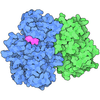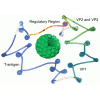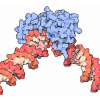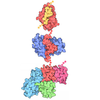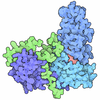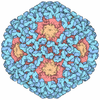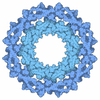+ Open data
Open data
- Basic information
Basic information
| Entry | Database: PDB / ID: 9ivd | ||||||||||||||||||||||||
|---|---|---|---|---|---|---|---|---|---|---|---|---|---|---|---|---|---|---|---|---|---|---|---|---|---|
| Title | Cryo-EM structure of CyclinD1 bound AMBRA1-DDB1 | ||||||||||||||||||||||||
 Components Components |
| ||||||||||||||||||||||||
 Keywords Keywords | SIGNALING PROTEIN / E3 ligase | ||||||||||||||||||||||||
| Function / homology |  Function and homology information Function and homology informationpositive regulation of free ubiquitin chain polymerization / cyclin D1-CDK4 complex / cyclin D1-CDK6 complex / re-entry into mitotic cell cycle / Drug-mediated inhibition of CDK4/CDK6 activity / RUNX3 regulates WNT signaling / response to mitochondrial depolarisation / positive regulation of mammary gland epithelial cell proliferation / positive regulation of mitophagy / response to leptin ...positive regulation of free ubiquitin chain polymerization / cyclin D1-CDK4 complex / cyclin D1-CDK6 complex / re-entry into mitotic cell cycle / Drug-mediated inhibition of CDK4/CDK6 activity / RUNX3 regulates WNT signaling / response to mitochondrial depolarisation / positive regulation of mammary gland epithelial cell proliferation / positive regulation of mitophagy / response to leptin / Transcriptional regulation by RUNX2 / Leydig cell differentiation / positive regulation by virus of viral protein levels in host cell / spindle assembly involved in female meiosis / proline-rich region binding / epigenetic programming in the zygotic pronuclei / cyclin-dependent protein serine/threonine kinase activator activity / Regulation of RUNX1 Expression and Activity / UV-damage excision repair / response to iron ion / neural tube development / positive regulation of regulatory T cell differentiation / biological process involved in interaction with symbiont / negative regulation of cardiac muscle cell apoptotic process / mammary gland epithelial cell proliferation / cyclin-dependent protein serine/threonine kinase regulator activity / regulation of mitotic cell cycle phase transition / response to UV-A / WD40-repeat domain binding / response to corticosterone / Cul4A-RING E3 ubiquitin ligase complex / response to vitamin E / Cul4-RING E3 ubiquitin ligase complex / negative regulation of epithelial cell differentiation / Cul4B-RING E3 ubiquitin ligase complex / Macroautophagy / ubiquitin ligase complex scaffold activity / fat cell differentiation / PTK6 Regulates Cell Cycle / negative regulation of reproductive process / negative regulation of developmental process / Defective binding of RB1 mutants to E2F1,(E2F2, E2F3) / microtubule organizing center / cullin family protein binding / viral release from host cell / response to magnesium ion / regulation of G1/S transition of mitotic cell cycle / Transcriptional Regulation by VENTX / protein phosphatase activator activity / RUNX3 regulates p14-ARF / axoneme / mammary gland alveolus development / autophagosome assembly / Estrogen-dependent nuclear events downstream of ESR-membrane signaling / bicellular tight junction / positive regulation of G2/M transition of mitotic cell cycle / response to X-ray / positive regulation of G1/S transition of mitotic cell cycle / ectopic germ cell programmed cell death / positive regulation of viral genome replication / ubiquitin-like ligase-substrate adaptor activity / Regulation of MITF-M-dependent genes involved in cell cycle and proliferation / proteasomal protein catabolic process / endoplasmic reticulum unfolded protein response / mitophagy / cyclin-dependent protein kinase holoenzyme complex / phagocytic vesicle / lactation / mitotic G1 DNA damage checkpoint signaling / transcription repressor complex / positive regulation of gluconeogenesis / liver regeneration / positive regulation of autophagy / autophagosome / cellular response to starvation / protein serine/threonine kinase activator activity / Ubiquitin-dependent degradation of Cyclin D / nucleotide-excision repair / Recognition of DNA damage by PCNA-containing replication complex / G1/S transition of mitotic cell cycle / response to calcium ion / regulation of circadian rhythm / DNA Damage Recognition in GG-NER / Dual Incision in GG-NER / Transcription-Coupled Nucleotide Excision Repair (TC-NER) / Pre-NOTCH Transcription and Translation / Formation of TC-NER Pre-Incision Complex / SCF(Skp2)-mediated degradation of p27/p21 / response to estrogen / Formation of Incision Complex in GG-NER / RMTs methylate histone arginines / histone deacetylase binding / Wnt signaling pathway / neuron differentiation / protein polyubiquitination / Dual incision in TC-NER / Gap-filling DNA repair synthesis and ligation in TC-NER / positive regulation of protein catabolic process / Cyclin D associated events in G1 / cellular response to UV Similarity search - Function | ||||||||||||||||||||||||
| Biological species |  Homo sapiens (human) Homo sapiens (human) | ||||||||||||||||||||||||
| Method | ELECTRON MICROSCOPY / single particle reconstruction / cryo EM / Resolution: 3.55 Å | ||||||||||||||||||||||||
 Authors Authors | Wang, Y. / Liu, M. / Su, M.-Y. / Stjepanovic, G. | ||||||||||||||||||||||||
| Funding support |  China, 1items China, 1items
| ||||||||||||||||||||||||
 Citation Citation |  Journal: Sci Adv / Year: 2025 Journal: Sci Adv / Year: 2025Title: Mechanism of D-type cyclin recognition by the AMBRA1 E3 ligase receptor. Authors: Yang Wang / Ming Liu / Shan Wang / Xinyi Mai / Xi Wang / Fei Teng / Tianrui Lyu / Ming-Yuan Su / Goran Stjepanovic /  Abstract: AMBRA1 is a tumor suppressor protein that functions as a substrate receptor in the ubiquitin conjugation system and regulates the stability of D-type cyclins and cell proliferation. Here, we present ...AMBRA1 is a tumor suppressor protein that functions as a substrate receptor in the ubiquitin conjugation system and regulates the stability of D-type cyclins and cell proliferation. Here, we present the cryo-EM structure of cyclin D1-bound AMBRA1-DDB1 complex at 3.55-Å resolution. The structure reveals a substrate interaction surface on the AMBRA1 WD40 domain that specifically binds to the C-terminal region of D-type cyclins. This interaction is dependent on the phosphorylation of Thr residue in the C-terminal phosphodegron site of D-type cyclins. The phosphodegron motif folds into a turn-like conformation, followed by a 3 helix that promotes its assembly with AMBRA1. In addition, we show that AMBRA1 mutants, which are defective in cyclin D1 binding, lead to cyclin D1 accumulation and DNA damage. Understanding the AMBRA1-D-type cyclin structure enhances the knowledge of the molecular mechanisms that govern the cell cycle control and may lead to potential therapeutic approaches for cancers linked to abnormal cyclin D activity. | ||||||||||||||||||||||||
| History |
|
- Structure visualization
Structure visualization
| Structure viewer | Molecule:  Molmil Molmil Jmol/JSmol Jmol/JSmol |
|---|
- Downloads & links
Downloads & links
- Download
Download
| PDBx/mmCIF format |  9ivd.cif.gz 9ivd.cif.gz | 226.8 KB | Display |  PDBx/mmCIF format PDBx/mmCIF format |
|---|---|---|---|---|
| PDB format |  pdb9ivd.ent.gz pdb9ivd.ent.gz | 164.3 KB | Display |  PDB format PDB format |
| PDBx/mmJSON format |  9ivd.json.gz 9ivd.json.gz | Tree view |  PDBx/mmJSON format PDBx/mmJSON format | |
| Others |  Other downloads Other downloads |
-Validation report
| Summary document |  9ivd_validation.pdf.gz 9ivd_validation.pdf.gz | 1 MB | Display |  wwPDB validaton report wwPDB validaton report |
|---|---|---|---|---|
| Full document |  9ivd_full_validation.pdf.gz 9ivd_full_validation.pdf.gz | 1 MB | Display | |
| Data in XML |  9ivd_validation.xml.gz 9ivd_validation.xml.gz | 40.7 KB | Display | |
| Data in CIF |  9ivd_validation.cif.gz 9ivd_validation.cif.gz | 62 KB | Display | |
| Arichive directory |  https://data.pdbj.org/pub/pdb/validation_reports/iv/9ivd https://data.pdbj.org/pub/pdb/validation_reports/iv/9ivd ftp://data.pdbj.org/pub/pdb/validation_reports/iv/9ivd ftp://data.pdbj.org/pub/pdb/validation_reports/iv/9ivd | HTTPS FTP |
-Related structure data
| Related structure data |  60925MC M: map data used to model this data C: citing same article ( |
|---|---|
| Similar structure data | Similarity search - Function & homology  F&H Search F&H Search |
- Links
Links
- Assembly
Assembly
| Deposited unit | 
|
|---|---|
| 1 |
|
- Components
Components
| #1: Protein | Mass: 33847.090 Da / Num. of mol.: 1 Source method: isolated from a genetically manipulated source Source: (gene. exp.)  Homo sapiens (human) / Gene: CCND1, BCL1, PRAD1 / Production host: Homo sapiens (human) / Gene: CCND1, BCL1, PRAD1 / Production host:  Homo sapiens (human) / References: UniProt: P24385 Homo sapiens (human) / References: UniProt: P24385 |
|---|---|
| #2: Protein | Mass: 44496.871 Da / Num. of mol.: 1 Source method: isolated from a genetically manipulated source Source: (gene. exp.)  Homo sapiens (human) / Gene: AMBRA1, DCAF3, KIAA1736 / Production host: Homo sapiens (human) / Gene: AMBRA1, DCAF3, KIAA1736 / Production host:  Homo sapiens (human) / References: UniProt: Q9C0C7 Homo sapiens (human) / References: UniProt: Q9C0C7 |
| #3: Protein | Mass: 127097.469 Da / Num. of mol.: 1 Source method: isolated from a genetically manipulated source Source: (gene. exp.)  Homo sapiens (human) / Gene: DDB1, XAP1 / Production host: Homo sapiens (human) / Gene: DDB1, XAP1 / Production host:  Homo sapiens (human) / References: UniProt: Q16531 Homo sapiens (human) / References: UniProt: Q16531 |
| Has ligand of interest | Y |
| Has protein modification | Y |
-Experimental details
-Experiment
| Experiment | Method: ELECTRON MICROSCOPY |
|---|---|
| EM experiment | Aggregation state: PARTICLE / 3D reconstruction method: single particle reconstruction |
- Sample preparation
Sample preparation
| Component | Name: Complex of AMBRA1-DDB1 bound to CyclinD1-CDK4 / Type: COMPLEX / Entity ID: all / Source: RECOMBINANT |
|---|---|
| Molecular weight | Value: 0.244 MDa / Experimental value: NO |
| Source (natural) | Organism:  Homo sapiens (human) Homo sapiens (human) |
| Source (recombinant) | Organism:  Homo sapiens (human) Homo sapiens (human) |
| Buffer solution | pH: 7.4 |
| Specimen | Embedding applied: NO / Shadowing applied: NO / Staining applied: NO / Vitrification applied: YES |
| Vitrification | Cryogen name: ETHANE |
- Electron microscopy imaging
Electron microscopy imaging
| Experimental equipment |  Model: Titan Krios / Image courtesy: FEI Company |
|---|---|
| Microscopy | Model: FEI TITAN KRIOS |
| Electron gun | Electron source:  FIELD EMISSION GUN / Accelerating voltage: 300 kV / Illumination mode: SPOT SCAN FIELD EMISSION GUN / Accelerating voltage: 300 kV / Illumination mode: SPOT SCAN |
| Electron lens | Mode: BRIGHT FIELD / Nominal defocus max: 1800 nm / Nominal defocus min: 1000 nm |
| Image recording | Electron dose: 1.198 e/Å2 / Film or detector model: GATAN K3 (6k x 4k) |
- Processing
Processing
| EM software | Name: PHENIX / Category: model refinement | ||||||||||||||||||||||||
|---|---|---|---|---|---|---|---|---|---|---|---|---|---|---|---|---|---|---|---|---|---|---|---|---|---|
| CTF correction | Type: NONE | ||||||||||||||||||||||||
| 3D reconstruction | Resolution: 3.55 Å / Resolution method: FSC 0.143 CUT-OFF / Num. of particles: 1015935 / Symmetry type: POINT | ||||||||||||||||||||||||
| Refine LS restraints |
|
 Movie
Movie Controller
Controller




 PDBj
PDBj